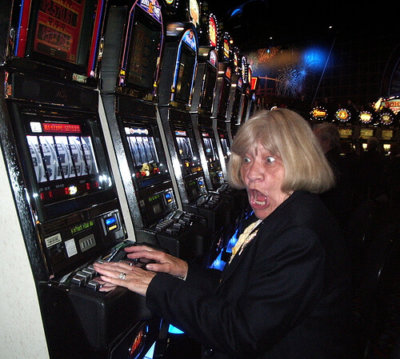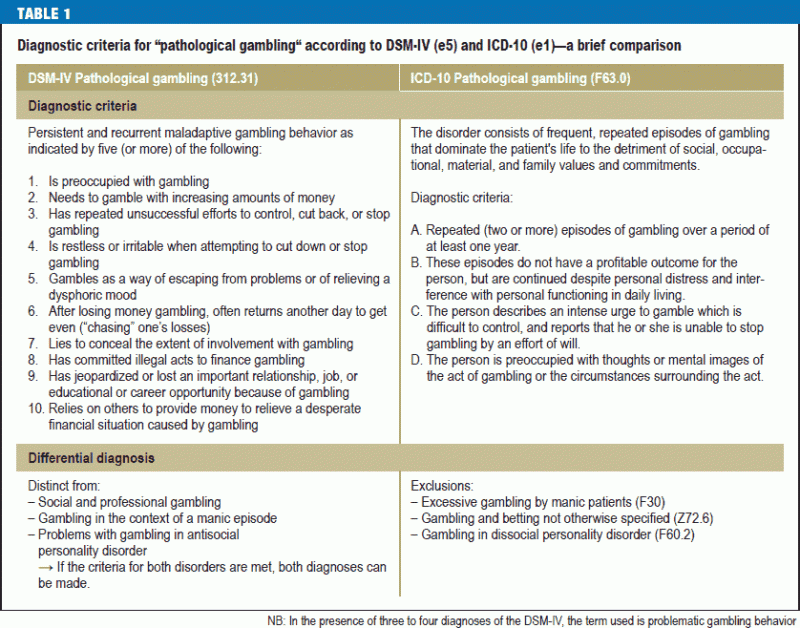The many labels used to describe gambling problems are a source of confusion for the public and frustration for researchers. Commonly used terms include “problem”, “at risk”, “compulsive”, “disordered”, and “pathological” gambling. Pathological gambling, also known as compulsive gambling, refers to the raving urge to gamble even if it has negative consequences. It is similar to obsessive-compulsive disorder and is one of the types of impulse-control disorders where the person is unable to resist the impulses and engage in excessive gambling.
Pathological gambling disorder is seen as gambling which is uncontrollable and can alter and adversely affect the individual’s recreational and social activities. This disorder has an extremely disruptive and adverse affect on the life of the individual that suffers from it. As a result of this pathological gambling, individuals may end up losing all of their life savings, and may also be forced to commit various crimes including forging checks, stealing or embezzling in order to acquire more money to fulfill their compulsive habit. This disorder can also lead to the development of major problems in relationships as well as jobs.
Pathological gambling can also be described as an Impulse Control Disorder1 or process addiction which is different from addictions to elements such as alcohol, food, tobacco and drugs. These types of addictions include a ‘high’ or a ‘rush’ which is gained when certain actions are performed as part of the addictive behavior. In case of gambling, the individuals may gain the ‘high’ from the overall setting and atmosphere of the place, for example a bingo hall, casino, race track and other places. The feeling that the individual gets from taking risks in this environment can evoke the addiction further. In many cases it is seen that compulsive gamblers own a piece of clothing or accessory which they claim is lucky for their gambling, and hence wear it every time they participate in a gambling activity. Some of these individuals use the piece of clothing or accessory to acquire the ‘high’ or ‘rush’ before gambling.
Causes:
The definite causes of pathological gambling disorder are unknown, although there are a number of studies and surveys that indicate that there is a significant difference on biological levels, between the general population and the compulsive gamblers. These surveys however cannot form the basis of the causes of pathological gambling. Many people tend to use their habit of gambling in order to gain an escape from signs of depressions which is more commonly seen in women than in men. Some of the gamblers seek to gamble in order to alter their moods because of the intense amount of energy and excitement that is commonly seen in gambling rooms. Thus, it is common to find that some people may be interested in other aspects of gambling than simply the money that is involved. It can be said that they ‘rush’ or ‘high’ that is seen in individuals suffering from pathological gambling disorders may not be associated with the money.
Symptoms:
Some of the most common symptoms that are seen in individuals suffering from pathological gambling disorder include immense amount of preoccupation with activities associated with gambling which tend to interfere with the individual’s social, occupational and personal life. The individual fells that he/she cannot control these gambling instincts and thus continues to visit casinos to place bets, failing to stop or cut down on the habit. One of the most commonly seen behaviors among compulsive gamblers is known as chasing. Chasing refers to placing bets of large amounts of money and thus taking more risks. This is done in order to make up for money that has been lost in gambling previously by the individual. The individual is also prone to immoral activities such as lying, forgery, stealing, fraud involved with credit cards, embezzling, and various other behaviors that are associated with acquiring money for gambling.
Demographics:
Gambling disorder affects more males than females in the United States with a sex ratio of 2:1. Over all as many as 4% of the population of the United States might meet the criteria for the disorder. In some countries this percentage is as high as 7%.
Diagnosis:
The disorder is usually diagnosed when an affected persons family or spouse become concerned and is seldom self reported. The most common symptom that most patients suffer from is Denial.
The Diagnostic and Statistical Manual of Mental Disorders(4th edition), specifies that a person affected with pathological gambling disorder must have at least 5 of the following symptoms to meet the diagnostic criteria for the disorder:
- The person thinks about gambling almost all the time
- The person keeps using larger and larger amounts of money every time when gambling
- The person has tried to stop gambling but has been unable to do so
- Whenever the gambling is stopped, the person becomes moody or cranky
- The person uses gambling as a method to escape problems
- The person continues to gamble in order to win back the money that has been lost (“chasing”)
- The person lies about the severity and extent of gambling
- The person has engaged in illegal or immoral behavior in order to make money for gambling
- The person has problems at home or work because of the gambling
- The person tends to rely on other people to get out of financial problems that have been caused by gambling
Treatments:
There are many treatments available for pathological gambling disorder:
- Psychodynamic Psychotherapy
- Cognitive Behavioral Therapy
- Substance Abuse Treatment
- Relaxation Techniques
- Aversion Therapy
- Gamblers Anonymous


References:
Impulse Control Disorders: A Clinician’s Guide to Understanding and Treating Behavioral Addictions Jon E. Grant
APA: Diagnostic and Statistical Manual of Mental Disorders. 4th ed. text revision
What is Pathological gambling
Pathological gambling is a inpulse-control disorder. This means that a person acts on certain impulse that is potentially harmful but they cannot resist the action. This is not the same as problem gambling.
In pathological gambling (disorder), there is a chronic inability to resist the impulse of gambling in a person. This is to the extent when gambling is so serious that it damages a person’s financial, functional, social and vocational life.
Statistics on Pathological gambling
Although comprehensive studies worldwide have not been compiled, there are local studies that all point to a 3-5% rate of problem gamblers in the general population, and approximately 1% rate of pathological gamblers.
Australia has a long history of gambling, and the highest per capita expenditure on gambling of all Western nation. Hence it is no surprise that pathological gambling is on the rise in Australia.
Risk Factors for Pathological gambling
There are several predisposing factors that are seen in pathological gamblers. Aside from early exposure to peer pressure, the following are the risk factors:
- Risk-taking behaviour: those who have morbid risk-taking behaviour are more likely to be pathological gambler, since gambling is a type of risk-taking. These people can have high attempted suicide rates as well.
- Mental disorder: pathological gambling may occur in any mental disorder, however it is most commonly associated with depression. Alcohol misuse/dependence and substance misuse/dependence are also common.
- Genetics/Hereditary: Studies have shown that childhood experiences and influences in early life can increase the risk of pathological gambling.
Progression of Pathological gambling
The typical pathological gambler is in the age group of 30-40s. The disorder often starts off like described below. In the settings of a big win or life stresses (as detailed below), the gambler starts to spend more time and money to engage in multiple gaming opportunities. Over the time frame from months to years, he or she begins to fall behind and hence repeating the spiral down again, instead of cutting and stopping loses. When all the options of obtaining money failed, men tend to resort to scams and credit card fraud; while women may go into prostitution.
Generally, the pathological gamblers have a fluctuating course of disease. Depending on social situations and life events (e.g. stresses in life, relationship problems, financial crises, pregnancy, etc), pathological gambling can recur after some time of remission. Remission means that the person have the features of pathological gambling (as described below in clinical history).
Some pathological gamlers will seek help and quit, yet many will run the vicious cycle as described above until serious complications occur.
How is Pathological gambling Diagnosed?
Because this is a psychiatric disorder, no routine laboratory investigations are useful for the diagnosis of pathological gambling. Yet, as in clinical examination, some basic tests may show features of other disorders, such as alcoholism. Urine screen might show recreational drugs in the urine.
Prognosis of Pathological gambling
The prognosis of pathological gambling can be varied, depending on the underlying disorders or personality. Also it depends on the severity of life stresses or any triggering factors that initiated the cycle of pathological gambling.
Pathological Gambling Treatment
How is Pathological gambling Treated?
Management of pathological gambling involves changing the lifestyle of the patient. For optimal outcome, it is important to involve a whole team of mental health workers, including psychiatrist, psychologist, social worker, counsellor, general practitioner and others.
The following treatment options are most likely to be used in combination:
- counselling: this need to assess the financial situation, marriage, relationship with spouse/partner, and other social issues that are affected by pathological gambling.
- self-help group: e.g Gamblers Anonymous Australia to provide social support for the individual and the family.
- psychological treatment: good outcome has been reported using cognitive-behavioural therapy. This is a psychological therapy first requiring the patient to recognise the disorder, then using step-by-step methods to treat pathological gambling. If complete stoppage cannot be achieved, sometimes controlled gambling can have good outcomes as well.
- psychiatric treatment: if there are any other mental disorders undelying pathological gambling, the patient need to have psychiatric assessment for further treatment.
Pathological gambling References
[1] Dickerson M, Baxter P, Boreham P, Harley W, Williams J. Report of the First Year of the Study into the Social Impact of the Introduction of Gaming Machines to Queensland Clubs and Hotels, The State of Queensland (Department of Families, Youth and Community Care), 1995.Symptoms Of Pathological Gambling

[2] Gelder M, Lopez-Ibor JJ, Andreasen N. New Oxford Textbook of Psychiatry. Oxford University Press. 2003.
First Responsible Gaming Program
 [3] JAMA Patient Page: WHen Gambling Becomes a Bad Bet [online]. 2001. [Cited 2005 September 22nd]. Available from: URL:
[3] JAMA Patient Page: WHen Gambling Becomes a Bad Bet [online]. 2001. [Cited 2005 September 22nd]. Available from: URL:http://www.hmc.psu.edu/healthinfo/articles/gambling.pdf
[4] Sadock BJ, Sadock VA. Kaplan and Sadock’s Comprehensive Textbook of Psychiatry. 8th ed. Lippincott Williams & Wilkins. 2005.